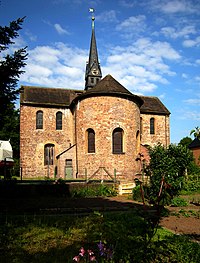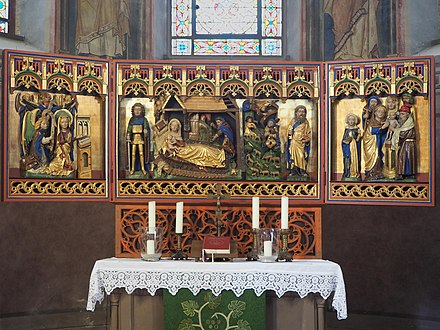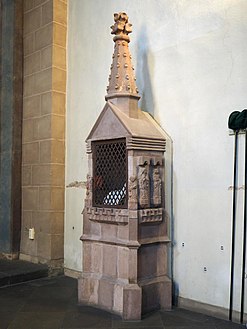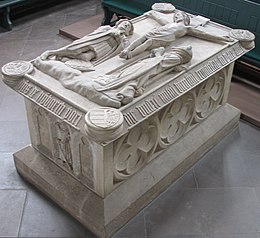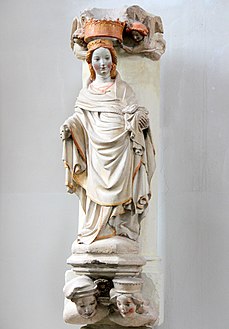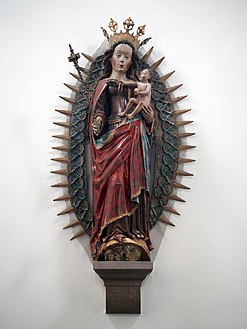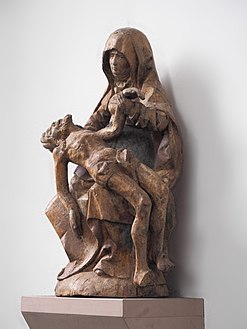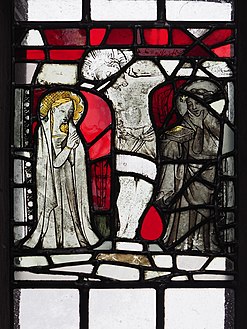Kemnade Monastery Church
The former monastery church of St. Marien is a three-aisled Romanesque church in Kemnade , a district of Bodenwerder (Lower Saxony). Today it serves as the parish church of the Evangelical Lutheran parish Bodenwerder-Kemnade in the parish of Holzminden-Bodenwerder of the regional church of Hanover .
The history of the monastery is covered in the article → Kemnade Monastery .
Design and history
The building is a typical example of Salic architecture, a Romanesque period under the Salic emperors in the 11th and 12th centuries. It is a flat-roofed three-aisled pillar basilica on a Latin cross floor plan with a transept and separated crossing . A rectangular choir bay with an apse is attached to the crossing to the east. The transept arms originally also had an apse. The poorly structured masonry consists of broken red sandstone, the roof is covered with sandstone slabs.
Presumably after damage during the Thirty Years' War , the west tower and 20 meters of the originally 53.70 m long nave were removed. The nave is therefore greatly shortened compared to its original state. Some of the originally arched windows were later changed in the Gothic style .
From 1837 St. Marien was restored by the district architect Friedrich Ludwig Haarmann . In 1896, the court decorator Adolf Quensen created the wall paintings in the apse. In 1899 the church received the roof turret over the crossing.
Furnishing
The altar
The winged altar dates from the 1st half of the 15th century. It shows the birth story of Jesus. The arrangement of the individual images is not original. Remnants of two altars have been put together. The wings were added in 1964.
- The left wing shows the Annunciation to Mary .
- In the middle you can see the birth of Jesus,
- on the right the Annunciation to the Shepherds .
- The right wing shows the offering in the temple .
Two figures of saints on the sides of the middle part complete the picture: on the left St. Adrianus , on the right presumably St. Peter .
The font
In 1964 the baptismal font was transferred from the St. John's Chapel in Tuchtfeld to the monastery church. It probably dates from the Romanesque period , its exact age and original provenance are unknown. The baptismal font has no Christian signs, only symbols such as the relief of a tree, which symbolizes paradise, and a wheel, which can be interpreted as the cherub guarding paradise .
The tabernacle
The red sandstone sacrament house dates from the Gothic period . It has the form of a small tower, on its gabled roof , a spire with final finial as roof skylights seated. At the height of the barred opening, figures have been inserted in relief on the sides, including a surrounding frieze. On the corner pillars there are two small angel figures swinging a censer. On the narrow sides there are two figures, on the left Peter with the key, next to Paul with the sword; on the right Mary with the child, next to it an unidentifiable figure of a saint.
Gravestones and tombstones
- The tumba of Count Siegfried von Homburg († 1380) and wife is a high grave made of sandstone. The walls are decorated with tracery and arcades. The Homburgs are shown in a high relief on the cover plate, kneeling in front of the cross with the Savior.
- In the crossing, a simple stone slab in the floor reminds us that Hieronymus Carl Friedrich Freiherr von Münchhausen (* 1720; † 1797), the so-called " Baron of Lies", was buried here.
- Various tombstones from the 16th / 17th centuries Century can be seen inside and outside.
The crucifixes
The two crucifixes come from different stylistic epochs.
- The small crucifix on the side wall is Romanesque (1000–1250) . It is the oldest piece in the monastery church. The cross and the color scheme are not original, however, but the figure shows typical Romanesque features: the feet stand next to each other (four-nail type), the loincloth falls straight down in folds.
- The large triumphal cross comes from the Gothic period (1250–1520) . It hangs in front of the sanctuary and shows the suffering Christ. The feet are crucified one above the other with a nail (three-nail type). The body is original, the cross was renewed in 1995.
The figure of Mary
A figure of Mary from the first half of the 15th century stands in front of a column (stele). Two angels hold a crown above Mary, which originally did not belong to the figure. This can be seen from the fact that Mary wears her own crown. At their feet you can see the heads of a man and a woman, probably the donor couple.
The Crescent Madonna
The 1.84 m high crescent moon Madonna made of lime wood was created around 1480. Part of the moon's face can be seen under her feet. It is surrounded by a halo, which, however, did not belong to the original figure. She wears a crown and a scepter in her right hand. The baby Jesus is sitting on her left arm, holding the globe in her left hand and grasping the cord with her right hand.
The Pietà
The 65 cm high sculpture made of linden wood was created around 1500. The Blessed Mother holds the body of her son on her lap.
Christ in misery (at rest)
The wooden figure with a height of 79 cm dates from the 15th century. Jesus is shown after the crowning of thorns and mockery. He is sitting abandoned on a rock, his head resting on his right hand, the bundle of rods in his left hand.
Medieval stained glass
Two remains of old windows can be seen in the Gothic window of the south transept. Presumably they come from the Homburg Chapel, which was a separate room in the north transept. The motif shown shows Christ on the cross between Mary and the apostle John .
Literature and other sources
- Georg Dehio, edited by Gerd Weiß: Handbook of German Art Monuments, Bremen, Lower Saxony, revised 1992 , ISBN 3-422-03022-0
- Michael Koch: Bibliography Höxter, Corvey and Corveyer Land. Münster 2015. (PDF file)
- Information boards about the works of art in the church
Web links
Individual evidence
- ^ Georg Dehio: Handbuch der deutschen Kunstdenkmäler, Bremen, Lower Saxony 1992, p. 794
- ^ Rudolf Lindemann: Two Romanesque fonts from the Einbeck area, in: Einbecker Jahrbuch 35, 1984, p. 110ff
Coordinates: 51 ° 59 ′ 1 ″ N , 9 ° 30 ′ 54.5 ″ E

